This from the Guardian:
Researchers at Manchester University have found that fracking causes less toxicity to humans and marine ecosystems and uses less resources than solar panels and wind turbines.
Their study, which measured the environmental impacts of fracking and compared it to other energy sources, prompted a story in the Times under the headline: Fracking ‘greener than solar panels’.
What follows is a discussion involving study authors, some experts, some interested parties and some of the general public. It makes for an interesting read, but it’s quite long, so I’ve taken a couple of points out of it which I think are of particular interest. The first being this question:
What do you think we can do to make the public discussion about fracking more rational, and less emotional? Do you think it [the discussion] needs to be more evidence-based?
I may have mentioned this exact thing over three years ago, right here. And as (report author) Laurence Stamford says:
Definitely. The shale debate is almost entirely based on rhetoric and hearsay (although this also applies to most topical issues e.g. nuclear). What we’re hoping to do here is simply to add some numbers and some neutral, evidence-based discussion to allow people to make informed judgements.
This is undoubtedly the best way to make informed judgements. But there are problems with this approach, namely that (predominantly) the bunnyhugger side know that in the struggle for hearts and minds, the hearts are generally the ones that win through. Appealing to people’s emotions will always be more successful in attracting supporters to your cause, so why bother with the uncomfortable truth of facts and figures that don’t support your case?
The flip side is that those facts and figures need to be independently sourced – or at least independently audited and verified – if we are going to consider them. All too often (and not just in the case of fracking), a bit of digging reveals that research, papers and reports have been funded by organisations with a specific interest in the subject under investigation.
Then there’s the interpretation of information by the media. The Times reported this study under the headline: “Fracking ‘greener than solar panels’, which Stamford says was not what he feels the study says:
“That makes it look like we are saying that solar panels are all around worse than shale gas, which… is not really what we’ve said. We are certainly not trying to say that shale gas is greener than renewables.”
He says it would be more accurate to say:
“For certain environmental problems shale is better than solar, whereas for others solar is better than shale.”
The lesson from this one? Don’t believe everything you read in the newspapers. Who knew?
And then what factors should be considered when comparing electricity generation technologies? Well, ideally, all of them, but then how much weight should be given to each – once again, there’s no easy way of answering that.
Interestingly, the major environmental concern related to solar was not investigated in the study. According to the solar industry, the turning over of agricultural land to solar farms is the biggest environmental public and policy obstacle the industry faces.
Yep – 6000 miles… covered that one too.
All in all, it’s an interesting study – albeit that people’s views on it have already been tarnished by that Times story – and a worthwhile discussion. A reminder on what we should be striving for when considering various forms of electricity generation and that the case for “renewables” isn’t always as clear cut as the anti-frackers would have us believe.




